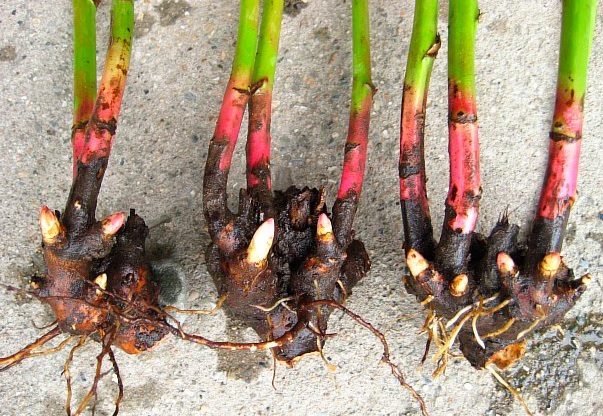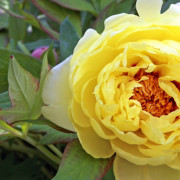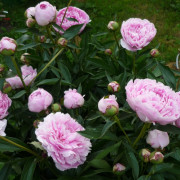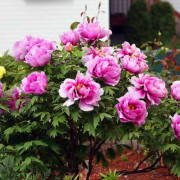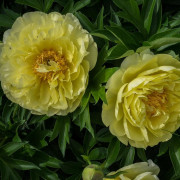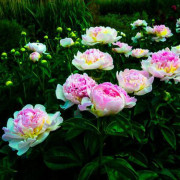Peony Bowl of Beauty (Paeonia Bowl of Beauty) - growing on the site
Content:
The specific name of the peony flower was given in honor of the ancient Greek mythological character, the abomination of evil, Pean, who healed the Olympian gods. The name of the Paeonia Bowl of Beauty is translated as “the bowl of beauty”.
Brief information
The incredibly beautiful Chinese herbaceous peony Bowl of Beauty was bred in 1949. Large flowers up to 20 cm in diameter have a pinkish-lilac color, in the center are light yellow staminodes. Emerald leaves have a characteristic glossy sheen.
For these light-loving plants, rich, fertile soils of medium moisture with good drainage are suitable. Sunny places are considered favorable for flowering, but the plants tolerate light shade.
Use in landscape design
The Bowl of Beauty peony, a lactic-flowered variety, perfectly adapts in the garden among other plants, suitable for borders and flower beds in city gardens and summer cottages. With peonies, you can make an informal hedge. In the garden, it is recommended to plant plants further away from trees and shrubs. The charming flower goes well with roses, irises and other perennials.
Abundant flowering and beauty of exquisite buds, a delightful aroma delights many fans. Picturesque bushes fit perfectly into flower beds, they are no less good in solo performance. The splendor of flowering is complemented by no less decorative foliage.
Unpretentious plants are easy to care for, which is why flower growers fell in love with them.
Advantages of the Bowl of Beauty peony variety:
- suitable for any style;
- allows you to create ensembles with lush bloom;
- unpretentious;
- does not create difficulties in leaving;
- drought-resistant;
- cold-resistant;
- durable.
The only drawback is that the aroma is weak, barely perceptible. The bowl of beauty peony thrives best in cool and temperate climates, as it can withstand low temperatures perfectly. Research has shown that the flower can withstand frost down to -40 ℃. This quality negates the possibility of plant death. Good drought resistance pleases everyone with its unusually beautiful appearance, even on the hottest days.
Growing and planting
The best time to plant is early fall. For such a period of time, the seedlings will have time to settle in the soil before winter. In the first year after planting, they do not bloom, sometimes it can take up to 2 years to get spectacular flowers.
Peonies to be transplanted must be over 5 years old. An adult bush is dug in from all sides, the rhizome is carefully pulled out of the recess and the adhering earth is shaken off it. Can be rinsed with water. This is necessary so that the kidneys are visible. Plants do not respond well to transplanting, so the planting site must be chosen with great care.
For plants to bloom well, light-loving peonies need a lot of sunlight, for at least six hours the bushes should receive it. Therefore, peonies especially delight with an abundance of lush buds in sunny places. A little shading at noon helps the flowers last longer.
Description of disembarkation step by step:
- Dig a hole about 50 cm deep and the same diameter.
- Add a layer of compost or humus.
- Set the root so that the eyes are pointing up and spread it out.
- The root should be placed 5 cm below the soil surface.
- Fill the hole with soil, making sure it does not cover the root deeper than 5 cm.
- Tamp and water liberally.
Peonies are propagated in two ways from seeds and by dividing the bush. The latter method is most preferred. When propagated by seeds, peonies bloom no earlier than 5 years later. This is the main drawback of this method. It is usually used by breeders when developing new varieties.
The collected seed is planted in beds to a depth of 5 cm. With this planting, a two-stage stratification is provided. The first stage is warm (15-30 ℃), the second stage is cold (5-10 ℃). After such treatment, the main part germinates in the next season, the rest in a year. For winter sowing of seeds, you need a heating pad with a temperature regulator and a container with sand. Crockery with crops is placed on the burner and heated in stages to 30 ℃ during the day, and 15 ℃ at night.
Such treatment is carried out within a month, and regular spraying is required. After the roots appear on the seeds, they proceed to the second stage. For this, the seed is transferred to another container with a fertile substance until the first leaves appear, maintaining a temperature of 5-10 ℃. The final stage continues at room temperature and regular moisture. Then the sprouts are moved to a permanent place.
Plant care
The Bowl of Beauty variety is grown in the same way as any other peonies, the rules of care are no different from the basic ones.
For lush flowering, it is recommended to mulch the soil with compost every autumn. Plants develop slowly, but they have a strong root system. It is she who provides such an amazing flowering.
Like all plants, peonies need spring feeding. Before flowering, it will be useful to feed the bushes with nitrogen and potash fertilizers. After the buds have dried, potassium and phosphorus are needed to form flower buds.
The first feeding after flowering is recommended to be carried out with organic fertilizers. A mullein is suitable for this purpose. A circular furrow is made around the bush, a solution is poured into it in a ratio of 1:10.
Another root dressing is carried out at the end of summer (August) using complex mineral fertilizers. In autumn, peonies do not need nitrogen, a phosphorus-potassium composition is suitable.
After flowering, foliar feeding can be done. It is performed by spraying the bush in dry weather with a solution with trace elements. Agricola is suitable: dissolve 5 milliliters of the mixture in 1 liter of water.
After heavy rain or heavy watering, a crust forms on the soil surface, which makes it difficult for air to reach the roots. To prevent this from happening, loosening is carried out. The procedure removes unwanted neighbors such as weeds from the bushes.
To make their life easier, gardeners mulch the soil around the plants. Grass, sawdust, or humus are used as mulch.
Flowering period
It begins to bloom in late spring and early summer. The active flowering phase lasts from 7 to 10 days. The plant has a height of 60 to 90 cm, the leaves remain attractive throughout the summer until the frost.
After flowering, nutrients are deposited in the adventitious roots. These reserves are helping to develop the ground system next spring. Also during this period, the kidneys develop.
Peonies after flowering
After the peonies have bloomed, the bush recovers and prepares for winter.It has buds, from which new shoots should appear next year.
Additional Information! All dry inflorescences are removed from the plant. Further, the bush all summer pleases with abundant greenery. In the fall, after it dries, it is simply cut off.
Damp earth promotes the formation of flower buds. You should not neglect the watering procedure so as not to expose the peony bushes to stress. Dry soil encourages the formation of weakened buds. This will lead to the fact that next year the plant will not bloom so abundantly. Watering is especially important when the weather is dry.
Plants do not tolerate transplanting well, it is a lot of stress for them. Therefore, it is not recommended to perform this procedure unnecessarily. Transplanting a large bush is allowed (at least 4-5 years old).
An important step is pruning after flowering. When it is better to do it depends on the weather. The main reference point is the air temperature. After the first frost has hit, the stems of the peonies begin to lie down: it's time for pruning. The aboveground part is removed from the plants. After pruning, the stems should protrude to a height of 2-3 cm.
Cut plants are recommended to be collected and sent to a compost pit (burned). You can not cover plants with cut tops for the winter - the stems are a breeding ground for pests.
Preparing peonies for wintering consists in mulching the ground around the bushes. A layer of humus or peat will do. The thickness of the mulch depends on the climatic conditions. In regions with a temperate climate, 10 cm is enough.In areas where the winter is harsh, the layer thickness can be increased to 20 cm.
Diseases
Roots can damage root nematodes. In addition, ants, aphids, and bronzes attack plants. It is important to recognize and eliminate diseases in time:
- rust;
- gray rot;
- powdery mildew;
- Lemoine's disease;
- leaf mosaic
Small signs of attention to the plant will allow you to wait for a gorgeous flowering next year. They have an elegant, sometimes even formal appearance. The main thing is to regularly monitor his condition and take timely measures to eliminate the signs of diseases.


